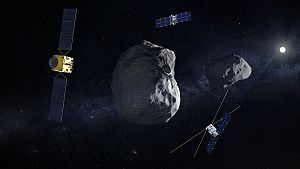HERA – a divine Mission

For the first time, a joint mission by the US space agency
NASA and the European Space Agency ESA, with the help of JOANNEUM RESEARCH, are attempting to deflect asteroids of typical hazard size. Gerhard Paar, an expert in Mars and simulations, is also involved in the HERA mission.
The name of the Greek mother of the gods, Hera, was chosen by ESA for the second part of the mission.
In the first part of the mission, also called "Dart", a space probe is steered by NASA with momentum towards an asteroid in order to bring it out of its orbit. The asteroid, called Dimorphos, is actually a moon of the Didymos double system, which make up about 15 per cent of all asteroids. With a diameter of 160 metres, it is of a size that could be dangerous to Earth's inhabitants in the event of an impact.
In the second part of the mission, the European probe of the HERA mission will be brought into orbit around the asteroid with a camera. One goal, if everything goes as planned, is to visualise the crater caused by "Dart". That's when the team led by Gerhard Paar and Piluca Caballo Perucha comes into play. The task is to measure Dimorphos and the larger Didymain in 3D during the approach in order to visualise the deflection manoeuvre on Didymain: "There is the assumption that, for example, rock fragments from the moon will land on the main celestial body, which can then be additionally measured. It is hoped that this will provide further
about the dynamics of the impact. The expectations for the success of this test deflection manoeuvre are high. For example, an impact of an asteroid with a diameter of 160 metres would destroy a city the size of Vienna.
ESA is investing 130 million euros in this mission - with a small part also from Austria, which is being made available to ESA by the BMK via FFG/ALR.
